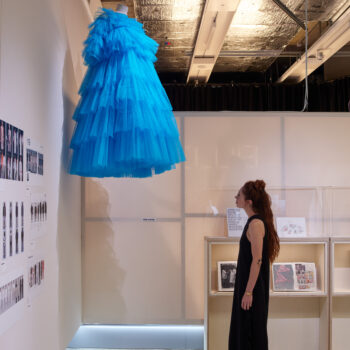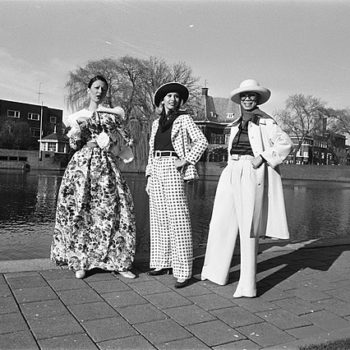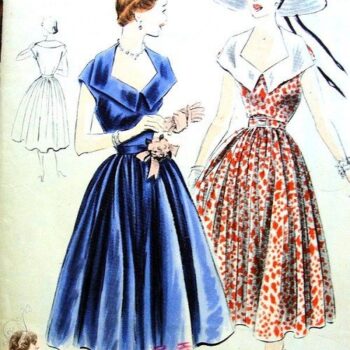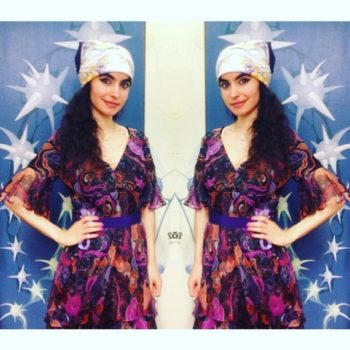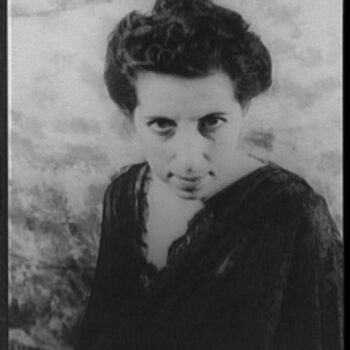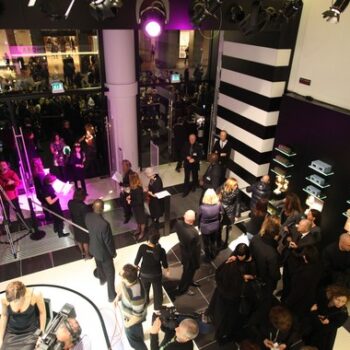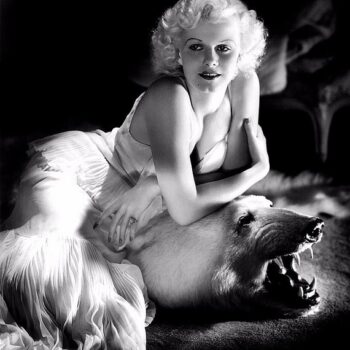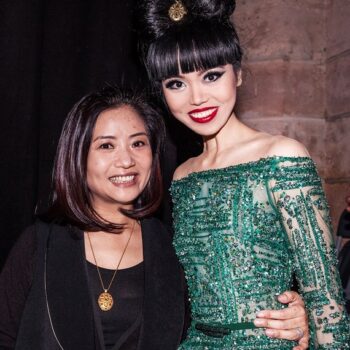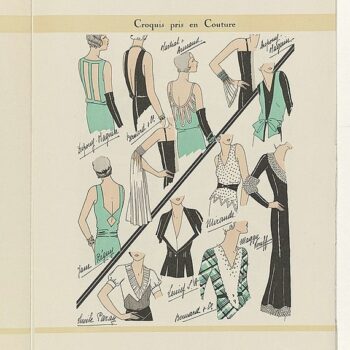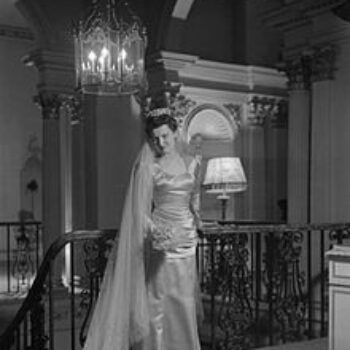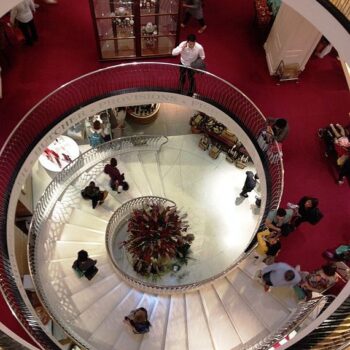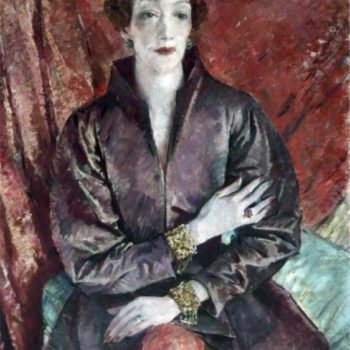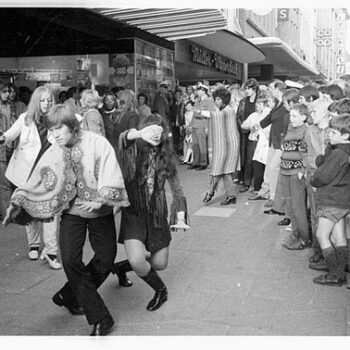Elsa Schiaparelli – 1890 – 1973 – Fashion Designs
September 28, 2014Elsa Schiaparelli really put the art into fashion, whereas before it would seem separate and distinguishable from art, Elsa paved the way for art and fashion to be intrinsically linked through colour, shape and feel.
Unlike many designers who’d gone before she collaborated openly with fellow artists, coming up with unusual shapes and surrealist fashion designs that would revolutionize the fashion world. Her style was both surreal and ironic offering women a refreshing change from the norm.
The iconic creations of Elsa Schiaparelli
Her work with Salvador Dali certainly gave her creations their surreal twist and many are a feast for the eye, almost as if they’d been specially created to tease and trick the eye into thinking they were seeing something else, an illusion, a piece of magic that could disappear at any moment and become something completely different, such was Schiaparelli’s humour and wit.
Claw gloves
Her claw gloves created in 1936 are no exception and would appear as part of her winter collection for that year. With their gold nails and long black velvet sleeves reaching the elbow,they give an impression of an elegant gauntlet ready to engage in battle, with saddle stitching and velvet arms, to wear them would certainly have given the wearer a certain degree of attention.
https://pinsndls.com/2012/07/17/guest-post-schiaparellis-shock-tactics-part-ii/
Schiaparelli Dresses -The Skeleton Dress
The skeleton dress was a testimony to Schiaparelli’s ability to create the most lucid of designs with images that fashion had not dared to create so far. The skeleton dress had padding at certain points of the dress giving it the illusion of a human skeleton. At the time it was considered bad taste, but was extraordinarily and hauntingly elegant,sitting on the body so naturally it could well have been a second skin.Created from matt silk, with layers of fabric and cotton to create the skeletal frame, it was a striking garment. The dress was a triumph. (1938)
The Shoe hat
The heeled shoe hat is probably one of Schiaparelli’s most famous creations of all. Like her claw gloves and skeleton dress, the hat was created towards the end of the thirties in 1937. Again this was a Salvador Dali collaboration; a photograph taken by Dali’s wife provided the inspiration with a picture of the artist with a woman’s shoe on his head and shoulder. The hat was a success and other similar ones were created with slight differences in colour and shape to the first. It was another example of Schiaparelli’s ingenuity.
From: https://www.blouinartinfo.com/news/story/804039/schiaparelli-reborn-is-the-late-fashion-designer-on-her-way-to
Schiaparelli-Iconic Creations – Bags
As well as hats, gloves and buttons Schiaparelli created some pretty amazing bags, which again, followed her sense of humour and surreal style. The lantern bag with its candy coloured handles and candy bows held a lantern shaped body with shiny black diamond stitching which would hold just enough to get you through the evening making you stand out for all the right reasons.
From: https://www.pinterest.com/pin/35958496997316387/
Many of Schiaparelli’s pieces are now held in museums all over the world and rightly so, for they are perfect examples of Schiaparelli as a leader in fashion, an innovator who made fashion fun, who combined art and fashion together and gave other fashion designers the courage to follow her lead and go with their own ideas, no matter how outlandish they have seemed to others
“Poverty forced me to work, and Paris gave me a liking for it.” – Elsa Schiaparelli
When you think of Schiaparelli,you think shoes, but you probably don’t think much about how she got to be so famous. We know her shoe, dress and bag designs were iconic and that she revolutionised fashion, that her influences were artistic, with Salvador Dali providing inspiration for many of her hats.
What we don’t know is how it all began. We don’t really need to know, but it makes her story that bit more interesting when we see what inspired her to become one of the most famous designers of the 20th century.
She was born in Rome, Italy to strict parents towards the end of the 19th century in 1890. She grew up in a Catholic home and her upbringing was strict,and even at this early stage she demonstrated a streak of rebelliousness by writing a book of poetry that was considered quite daring for the time.
She wanted to free herself from her background and did so with tremendous style. Her sense of dress was so vivid it was always remembered by those that met her including Givenchy, who on meeting her for the first time, remembers the hat she wore fondly, although he didn’t consider her a beautiful woman, he thought she was extremely chic.
Schiaparelli Marriage and London
Rather than stay with her parents and face the music Schiaparelli ran away to London and married a Polish Count at the tender age of eighteen. The married couple would move to the United States during the First World War where her husband would abandoned her, made worse by the fact that by this time she had a young daughter to support.
Born into Italian nobility in Rome in 1890, Elsa Schiaparelli, affectionately known as Schiap was causing outrage at a young age. Initially it was to her family, who didn’t enjoy the small book of poetry she wrote aged fifteen, and shipped her off to Swiss finishing school.When she escaped the school, she went to England where she attended a lecture on theosophy held a mysterious Professor Wilhelm de Wendt de Kerlor.
Schiap – Personal Life
They talked after the lecture, and on into the night, and by the next day were engaged. To her parent’s horror, the marriage went ahead shortly after.
Schiap and Wilhelm de Wendt de Kerlor
Professor W-de-W-de-K was sometime known as Count or Dr W-de-W-de-K, or sometimes just Mr. W-de-W-de-K. Just to ring the changes, alternatives on his name include William Kent, and Willie Wendt.
His nationality slipped about too, being everything from Polish (a Polish Count, in fact, which is what his descendants believed him to be) to Italian, French, and English. He was, in fact, Swiss, not a member of the nobility, and born Wilhelm Frederick Wendt.And it wasn’t only Wilhelm’s name that was changeable.
His job title and experience were completely flexible: some days, according to interviews he gave to the newspapers, he was running a university on parapsychology; on others he had read the palm of the Prince of Wales. He even, semi successfully, tried to start up a career in criminology, claiming to see details of murders in drops of blood left at the scene of the crime.
Deported from England
In actual fact, De Kerlor was deported from England a short time after his marriage to Schiap, and he and his new bride ended up crossing the world in search of new opportunities. Though his credentials were largely invented they were seldom doubted, and he seemed able to charm and convince wherever he went. He was also tireless in promoting himself, and knew little tricks like taking business addresses such as “1 Piccadilly Place”. It was actually just an alleyway off Piccadilly Circus, but never mind – it sounds good, right?
De Kerlor, the dodgy entrepreneur, never made much money and for the first year of marriage the couple were supported by Schiap’s dowry. When that ran out, she regularly sent to Italy for more cash from her family. Elsa worked hard alongside her husband to promote his business interests, and when the scoundrel left her after five years of marriage and just after their only daughter was born, perhaps she had taught her the value of unflagging self-promotion, and a good business front.
Rue de la Paix
When, in time, her own business was created, the atelier address in Paris would the Rue de la Paix, the premiere fashion boulevard of the time. The actual premises? An attic full of mice.
Schiaparelli’s Daughter
Schiaparelli’s child was called Maria Luisa Yvonne Radha de Kerlor, Gogo for short. The nickname stuck all her life. Why was she gifted with such an unusual pet name? Because, of course, the infant made all sorts of the usual baby like gurgling noises, goo, goo, ga ga etc, said Schiap. Gogo tells it differently: ‘A mad socialiser, Mummy got all dressed up every night for her umpteen dinner parties, leaving me with a nanny. Dashing out of the door she would always call to me, “Well, I must go now” and I would look up and say, “Go, go, going, go, go.” ‘
In fact, Mummy wasn’t such a bad mother and although Gogo felt that she grew up parent less, this is largely because she sadly contracted polio as a child.Schiap tried everything to cure her, and this involved long bouts of treatment in many different countries, usually far from Paris. In her memoirs, Schiap says that she missed her, and that it was hard to be parted from her. She tried to visit when she could.
Love affairs
Schiap did not marry again, although she dreamed of a man who could take care of her, rather than the other way around. She had several love affairs, one with a married man that was so scandalous that she was confronted with an angry mob. Another two was with a pair of brothers (also both married), more or less at the same time.
Schiap’s granddaughter is Marisa Berenson, the celebrated fashion model and film star. The celebrated designer died in 1973.
Schiaparelli was working for Gaby Picabia by now, who would then go on to introduce Elsa to Marcel Duchamp and Man Ray, and when they both went to Paris, she would join them. It was only part of the journey and it is here in Paris that she would start creating her fashions, starting with knitwear that was decorated with trompe l’oeil. Her fame would spread and one of her best clients Diane Vreeland would dedicate a magazine column to her in Harper’s Bazaar.
Schiaparelli couldn’t sketch her fashions and she had no idea how to sew, but this didn’t have much impact on her upward trajectory in the Paris fashion world of the 20s and 30s.And it certainly didn’t hinder her ability to create innovative hats, dresses and sweaters that were gaining in popularity and notoriety throughout the fashion capital.
Schiaparelli and the surrealists
Of course Schiaparelli is best known for her associations with Salvador Dali and Jean Cocteau, both surrealist artists and both would contribute toward her creations. From there we would have the lamp chop, shoe shaped hats, dresses and jumpers with ribs and skeletal bones on and bags in all manner of shapes and sizes.
From poverty to fame
Schiaparelli went from impoverished mother and abandoned wife to a famous designer that went on to have a tremendous influence on fashion throughout the 20th century. She would inspire both those inside and outside the world of fashion and innovate the way we see clothes. She would go on to influence designers such as Yves Saint Laurent, Jean Paul Gaultier and Christian Lacroix. Today, designers often take their inspiration from artists for their fashions in the same way that Schiaparelli once did, and because of her, designers think in a far more innovative and creative way.
Do you recognize this dress?
Elsa Schiaparelli collections-The House of Ideas
How about these designs?
Or this hat?
And you may have seen these gloves somewhere before…
These are all part of a run down of Elsa Schiaparelli’s greatest hits. Pretty cool, pretty weird and interesting, right? But, the funny thing is, the striking parts about them were influenced, suggested or downright designed by someone else. I mean, obviously, everyone gets inspired by other artists and designers.
But Salvador Dali actually sat down with Schiaparelli and said something like: “Why don’t we put a lobster on a dress? Let’s put it on a bag!” (Dali liked to put lobsters on everything that moved, or didn’t move).
“And by the way,” Dali continued, “I love relaxing with a shoe on my head, ha ha. Let’s do that!” (or words to that effect).
Schiap (as she often called herself) acknowledges that her “Tears” dress is explicitly based on Dali’s “Necrophiliac Springtime” painting, which she owned. And her Desk Suit, which is the dark picture above that’s a bit hard to see, but actually features brass drawer handles on a sober suit, is based on Dali’s particular obsessions, too.
Elsa Schiaparelli’s monkey fur shoes and fingernail gloves are so close to Meret Oppenheim’s ideas, which were created two years earlier, that it is impossible that Schiaparelli had never seen them.
And Jean Cocteau sold his design for the two faces that together make a vase, and the woman with the golden hair to the designer.
As well as this, novelty hats and novelty prints were not, er, a novelty, even by the 1930s.
It is perhaps to her detriment that these pieces are the ones you most prominently tend to see in relation to Elsa Schiaparelli, and in fact she is so often mentioned in relation to Dali and the Surrealists that it’s easy to assume she’s a minor female artist of the circle, perhaps even a hanger on of Dali, one who was also an accomplished seamstress.
Nonsense. In fact, she was a well-known Parisian couturier (actually she was Italian, but her business was based in Paris, you see) who was well established in making both very wearable and slightly madcap outfits for society by the time she met Dali in the mid 30s. Her house was opened in 1927.
She worked with a lot of artists: Leonor Fini designed her scent bottle (supposedly modeled on Mae West’s form), Jean Clement and Roger Jean-Pierre sold her ideas for buttons, Elsa Triolet offered her jewellery designs and Man Ray photographed the results.
Yet one would not call her a plagiarist or magpie-thief, but really someone along the lines of Lady Gaga who is continually inspired by, and collaborates with other artists, giving them full credit. (Though I’m not too sure about Meret Oppenheim, in fact.) Schiaparelli wrote that she, herself: “Went up into the rarified skies of her most fantastic imagination and set off cascades of fireworks. Fantasy and ingenuity broke forth, with complete indifference not merely to what people would say but even to what was practical.”
Elsa Schiaparelli Fashion Designs
Elsa Schiaparelli was never trained in tailoring or the art of fashion design. She could not cut, drape, sew or knit, being totally an ideas person.
She described the first outfit she made for a cocktail party, which was influenced by the Oriental harem pants of Paul Poiret. It consisted of a length of silk draped around the body and between the legs, held together with pins which flew out as she danced, leading to extreme outfit malfunction as the whole thing disintegrated.
Schiaparelli Designs and paul poiret
She adored the work of Poiret, and he adored her, often giving her gifts of opulent clothes. He encouraged her and supported her as a designer, but on the whole, her actual designs were not much influenced by him.
Schiaparelli pink
Her signature colour, “Shocking Pink” does have overtones of his hedonistic palette, but Schiaparelli was much more likely to use crisp black and white, or black and gold for a touch of luxury, than to employ brightly saturated hues.
Schiap was influenced more by the spirit of the times, and by clothes that she wanted to wear herself.
Schiaparelli designs and sportswear
Schiaparelli was a small person, slender but more of a boyish than an hourglass shape. She was not beautiful, but could look striking dressed in ways that suited her and that could be where she got her love of dramatic details and jewellery from. In addition, she loved sports such as skiing, and preferred to wear clothes that she could move in easily.
Sportswear was already creeping into everyday wear at the time, not jogging bottoms and trainers, but items like sweaters. However, they did not suit Elsa, falling shapelessly on her. One day in 1927 however, she saw an American woman wearing a sweater which had a dash more élan, and asked her where she got it from. It turned out to have been made by a professional knitter, an Armenian named Mike, and Schiap commissioned her to produce a design for her. This was her famous Trompe-l’œil bow jumper.
Schiaparelli Designs -The trompe l oeil sweater
She wore it to a dinner where an influential buyer for an American department store spotted it and ordered forty on the spot. Schiaparelli was in business.
In fact Coco Chanel, her life long sort-of friend and definite rival, was already making machine knitted sweaters alongside her relaxed clothing in jersey but Schiap became known as the queen of hand-knitted jumpers.
Schiaparelli Designs and Chanel
Chanel and Schiap moved in the same social circles and a pronounced illustration of their frenemy status came when they were both invited to a costume ball in 1938. Chanel came as herself, Schiap dressed as a Surrealist tree. Chanel invited her friend to dance and then, with purposeful innocence, steered her right into a chandelier ablaze with candles. The Italian designer was soon ablaze herself, and delighted guests put her out with squirts of soda water, storing the gossip for later.
Schiap also designed divided skirts, or, seen another way, baggy knee length trousers, which were meant for sport. Lili de Alvarez caused a delicious sensation wearing her Schiaparelli shorts to play tennis at Wimbledon in 1931.
Reflecting these designs, her first atelier was called “Pour Sport”. But Schiap quickly moved on from sport.
Elsa Schiaparelli Designs
Schiaparelli always liked to look elegant, but lacking natural curves and eschewing uncomfortable corsets she needed to find another way to sculpt the figure.
“You see, in designing, I consider both the clothes and the body architecturally; structure and line are the all important factors in the construction of fashions. And, of course, comfort too! Clothes must look as if they belong to the woman who wears them or they are not right.”
In 1931 Vogue explained: “Clothes carpenter that she is, Schiaparelli builds up the shoulders, planes them off, and carves a decisive line from under the arms to the hip bone, gouging in the waist.
Elsa Schiaparelli Designs and shoulder trays
She found that the use of exaggerated shoulder pads really made the waist look narrower in comparison. She called them “shoulder trays” and “angel wings”, reflecting just how big they became.
Elsa Schiaparelli Designs, a sound structural basis
Her outfits had this sound structural basis, to which she added playful twists like interesting buttons. She used the best tailors and embroiderers, not failing to head hunt skilled craftsmen (i.e. nick them from other designers) if she wanted them.
Her saleswomen were all beautiful and often titled society women, who would often double as models when needed.
Stockings, hats, jewellery and handbags
Her sharp business mind was ever active, and she made the most of her burgeoning brand with stockings, hats, jewellery and handbags in her name, as well as her “Shocking” perfume – again, a little after Chanel had introduced her own house perfumes.
versatile garments
During the Depression in America in the Thirties, when the rich could not really afford to buy so much couture, Schiap leapt in with versatile garments that were, for example, reversible. Or consisted of a skirt that transformed into a turban.
I’m not sure how that really worked in terms of designer cachet – surely you could either afford to buy top designer’s items or you couldn’t, and if you could you wouldn’t want to be known to be buying the one that saved you money by offering two garments in one. Perhaps that’s just how you explained it to your suicidal businessman husband – “But darling, I’m saving money, honest I am!”
Elsa Schiaparelli Designs and Avant-garde materials
Schiaparelli was one of the first to use zips when they were invented, but not for her the discreet setting of the fastener. She preferred to emblazon it across garments, making it a feature.
She also embraced modern technology in the use of new fabrics, including rhodophane, a fragile clear material which disappeared upon dry cleaning. “She’s got a lot of new crinkley things.” a reporter informed her readers in 1931. “[They look] so much like the bark of trees you feel you’re going to sprout leaves or acorns or something.” An evening gown of 1932 “looks as if it were made of crepe paper”
Her use of avant-garde materials also extended to interiors. Her dining chairs in one apartment were covered in a kind of rubber that was so unstable that once the guest’s bottoms had warmed it up a bit, it transferred to their derrieres making patterns that quite intrigued and delighted the irrepressible host.
Elsa Schiaparelli Designs and Bathing suits
On the inventive-yet-practical side, Schiaparelli designed and patented a bathing suit with built in bra, and went on to incorporate bras into dresses too.
Though the idea once or twice went wrong. “What do you think of my figure tonight?” asked Bettina Bergery, one of Schiap’s favourite models, as she went out one night in a dress padded with falsies. “Most interesting. You look like the Wolf of Rome.” replied her beau. The inserts had slipped, giving that sexy four breasted look.
Elsa Schiaparelli Designs and spreadsheets
Schiaparelli was organised as well as playful, and operated a system like a modern spreadsheet to keep track of each collection. She also had a system of tiny drawers for each design, storing the button, the fabric, and any other trimmings or details used.
Elsa Schiaparelli Designs and Film stars
Schiaparelli not only dressed film stars (Marlene Dietrich, Greta Garbo and Katherine Heburn were steadfast fans) but also designed costumes for many films and theatre plays, doing fifteen separate shows in a particularly busy two years.
Elsa Schiaparelli Designs – lobster dress
Wallis Simpson chose her lobster dress as honeymoon attire after marrying the Prince of Wales, in the belief its whimsy would soften people’s feelings towards her.
Her company had around 400 workers at its peak, and survived the Depression and the Second World War, finally closing in 1954.
Inheritors and Imitators
Directly and indirectly, Elsa Schiaparelli influenced a diverse range of fashion trends and designers.
Hubert de Givenchy worked alongside Schiaparelli in his early 20s, and credits her with influencing his outlook on fashion. She was reportedly furious with him when he left her start up his own label in 1951, and told him “You will bankrupt me.” Which perhaps shows how much she had come to rely on the young designer, rather than the other way around.
Elsa Schiaparelli Designs
Certainly looking at designs from both artists in 1951, there is a common theme of unusual uses of pleats and a similar shape of bodice, although who influenced whom or even if Givenchy designed the Schiaparelli piece before leaving is hard to say.
Other people who may have been influenced by Schiap include American designer Diane von Furstenberg. Perhaps it was an unconscious influence, or perhaps the idea really did come to her out of the blue but DVF claims to have invented the wrap dress in 1974.
Elsa Schiaparelli actually showed a very similar wrap dress way before that in 1930.
Inventions
It was one of her inventions which caused much joy from the burgeoning ready made clothes industry, who seemed more concerned in those days in actually making clothes fit. Adjustable as it was, it fit a range of variations on a woman’s figure without individual tailoring.
The power suit of the eighties, with its exaggerated shoulder pads, could be seen as a descendant of Schiaparelli’s broad shouldered jackets.
And witty and pretty Trompe-l’œil knits, reminiscent of Schiaparelli’s original designs pop up regularly on catwalks too.
Other influences
Elsa’s other influences are apparent at a glance – her “Tears” dress features rips in the fabric which shocked French society in the 30s – much like the torn clothing of Punks 60 or so years later. Although, possibly even the Punks didn’t base their clothes on a painting which refers to necrophilia, where the tidy strips of fabric represent dead, peeling skin. (Necrophiliac Springtime, by Salvador Dali).
She also, much like the Punks, loved using zips in prominent places.
Elsa Schiaparelli’s mantle
But as far as a contemporary couturier who can be said to have taken up Schiaparelli’s mantle, I nominate two: Jean Paul Gaultier with his desire to shock and his witty, irreverent designs, and Alexander McQueen with his strong tailoring skills that sculpted the body, fine craftsmanship, and also, a similar desire to shock.
Could McQueen’s exquisitely tailored bumsters be compared with those shoulder pads of Schiaparelli’s that reached quite ridiculous heights and widths?
And surely his feather headpieces resemble some of Schiap’s more outré creations?
Jean Paul Gaultier can claim a strong influence. This skeleton outfit for Dita Von Teese: was prefigured by Schiaparelli and Dali’s Skeleton dress. As, in a different way, was his “Cadaver” bodysuit. Elsa Schiaparelli also designed jumpers featuring sailor tattoos over the arms, an idea that Gaultier endlessly riffs on, and look at her perfume bottle: now look at his. Hmm. And finally Gaultier’s very funny trompe l’oeil lady – check out the fingernails. No, the FINGERNAILS!



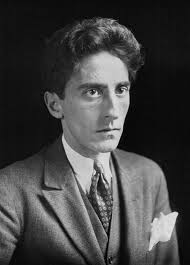
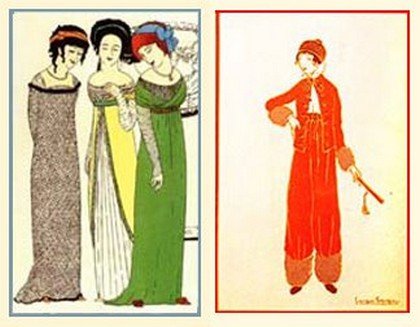
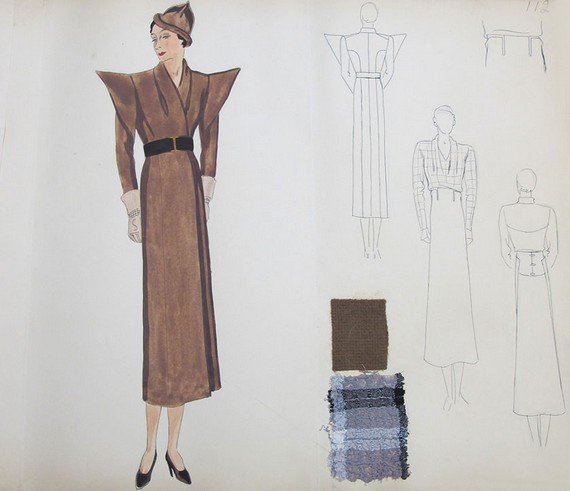
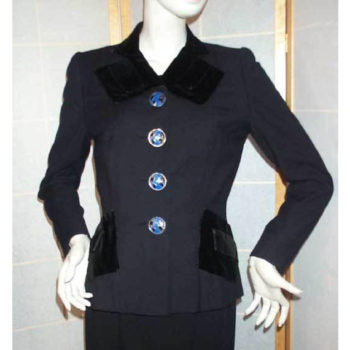

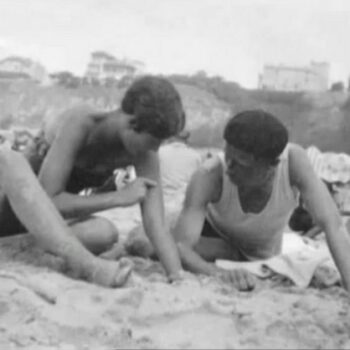
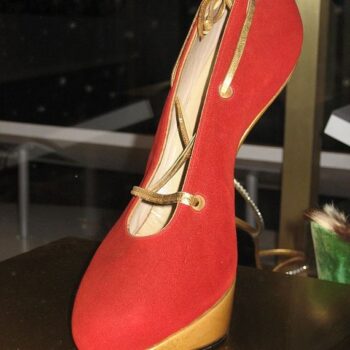
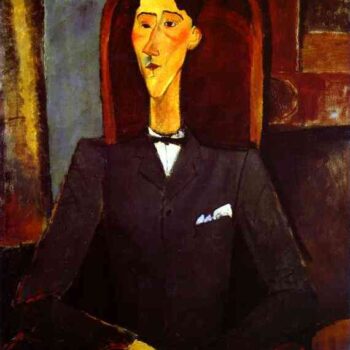
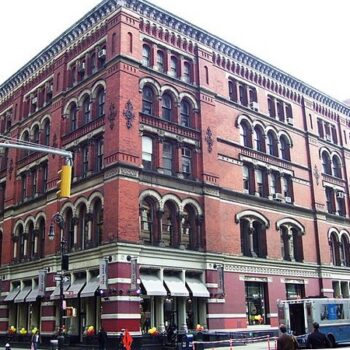
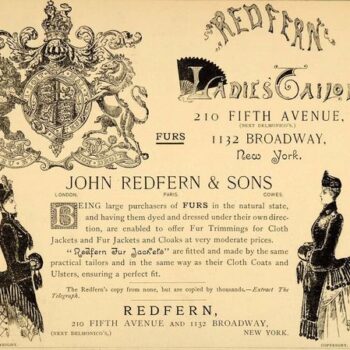
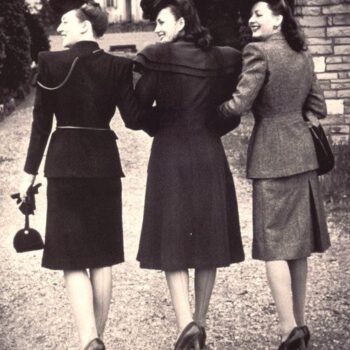
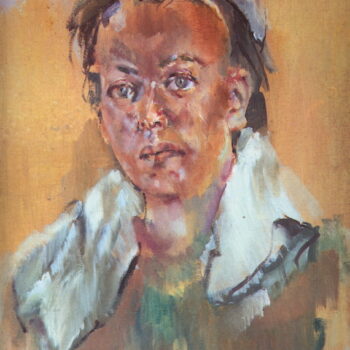
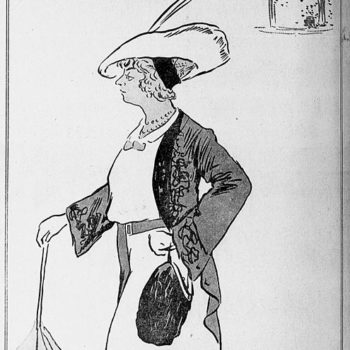
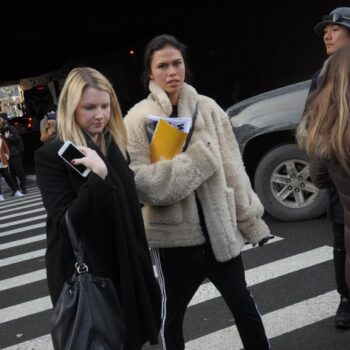
![What was 1980s fashion like, Gruppo_Italian, By Santulchix at the Italian Wikipedia project. [Public domain], via Wikimedia Commons](https://www.blue17.co.uk/wp-content/uploads/2018/04/What-was-1980s-fashion-like-Gruppo_Italian-By-Santulchix-at-the-Italian-Wikipedia-project.-Public-domain-via-Wikimedia-Commonso-350x350.jpg)

